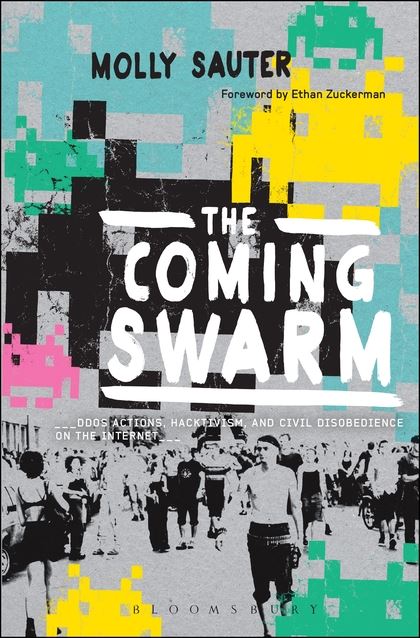a review of Molly Sauter, The Coming Swarm: DDoS Actions, Hacktivism, and Civil Disobedience on the Internet (Bloomsbury Academic, 2014)
~
Molly Sauter’s The Coming Swarm begins in an odd way. Ethan Zuckerman, director of MIT’s Center for Civic Media, confesses in the book’s foreword that he disagrees with the book’s central argument: that distributed denial of service (DDoS) actions, where specific websites and/or internet servers are overwhelmed by traffic and knocked offline via the coordinated activity of many computers acting together, should be viewed as a legitimate means of protest.[1] “My research demonstrated that these attacks, once mounted by online extortionists as a form of digital protection racket, were increasingly being mounted by governments as a way of silencing critics,” Zuckerman writes (xii). Sauter’s argument, which takes the form of this slim and knotty book, ultimately does not convince Zuckerman, though he admits he is “a better scholar and a better person” for having engaged with the arguments contained within. “We value civic arguments, whether they unfold in the halls of government, a protest encampment, or the comments thread of an internet post because we believe in the power of deliberation” (xv). This promise of the liberal public sphere is what Sauter grapples with throughout the work, to varying levels of success.
The Coming Swarm is not a book about DDoS activities in general. As Sauter notes, “DDoS is a popular tactic of extortion, harassment, and silencing” (6): its most common uses come from criminal organizations and government cyberwar operations. Sauter is not interested in these kinds of actions, which encompass the vast majority of DDoS uses. (DDoS itself is a subset of all denial of service or DoS attacks.) Instead they focus on self-consciously political DDoS attacks, first carried out by artist-hacker groups in the 1990s (the electrohippies and the Electronic Disturbance Theater) and more recent actions by the group Anonymous.[2] All told, these are a handful of actions, barely numbering in the double digits, and spread out over two decades. The focus on this small minority of cases can make the book’s argument seem question-begging, since Sauter does not make clear how and why it is legitimate to analyze exclusively those few instances of a widespread phenomenon that happen to conform to an author’s desired outlook. At one level, this is a general problem throughout the book, since Sauter’s analysis is confined to what they call “activist DDoS,” yet the actual meaning of this term is rarely interrogated: viewed from the perspective of the actors, many of the DDoS actions Sauter dismisses by stipulation could also be–and likely are–viewed as “activism.”
From its earliest inception, political DDoS actions were likened to “virtual sit-ins”: activists use their computers’ ability to ping a server to clog up its functioning, potentially slowing or bringing its activity to a stand-still. This situated the technique within a history of nonviolent civil disobedience, particularly that of the Civil Rights Movement. This metaphor has tended to overdetermine the debate over the use of DDoS in activist contexts, and Sauter is keen to move on from the connection: “such comparisons on the part of the media and the public serve to only stifle innovation within social movements and political action, while at the same time cultivating a deep and unproductive nostalgia for a kind of ‘ideal activism’ that never existed” (22-3). Sauter argues that not only does this leave out contributions to the Civil Rights Movement that the mainstream finds less than respectable; it helps rule out the use of disruptive and destructive forms of activism in future movements.
This argument has merit, and many activists who want to move beyond nonviolent civil disobedience into direct action forms of political action appear to agree with it. Yet Sauter still wants to claim the label of civil disobedience for DDoS actions that they at other moments discard: “activist DDoS actions are not meaningfully different from other actions within the history of civil disobedience… novelty cannot properly exempt activist DDoS from being classified as a tactic of civil disobedience” (27). However, the main criticisms of DDoS as civil disobedience have nothing to do with its novelty. As Evgeny Morozov points out in his defense of DDoS as a political tactic, “I’d argue, however, that the DDoS attacks launched by Anonymous were not acts of civil disobedience because they failed one crucial test implicit in Rawls’s account: Most attackers were not willing to accept the legal consequences of their actions.” Novelist and digital celebrity Cory Doctorow, who opposes DDoS-based activism, echoes this concern: “A sit-in derives its efficacy not from merely blocking the door to some objectionable place, but from the public willingness to stand before your neighbours and risk arrest and bodily harm in service of a moral cause, which is itself a force for moral suasion.” The complaint is not that DDoS fails to live up to the standards of the Civil Rights Movement, or that it is too novel. It is that it often fails the basic test of civil disobedience: potentially subjecting oneself to punishment as a form of protest that lays bare the workings of the state.
Zuckerman’s principle critique of Sauter’s arguments is that DDoS, by shutting down sites, censors speech opposed by activists rather than promoting their dissenting messages. Sauter has a two-pronged response to this. First, they say that DDoS attacks make the important point that the internet is not really a public space. Instead, it is controlled by private interests, with large corporations managing the vast majority of online space. This means that no arguments may rest, implicitly or explicitly, on the assumption that the internet is a Habermasian public sphere. Second, Sauter argues, by their own admission counterintuitively, that DDoS, properly contextualized as part of “communicative capitalism,” is itself a form of speech.
Communicative capitalism is a term developed by Jodi Dean as part of her critique of the Habermasian vision of the internet as a public sphere. With the commodification of online speech, “the exchange value of messages overtakes their use value” (58). The communication of messages is overwhelmed by the priority to circulate content of any kind: “communicative exchanges, rather than being fundamental to democratic politics, are the basic elements of capitalist production” (56). For Dean, this logic undermines political effects from internet communication: “The proliferation, distribution, acceleration and intensification of communicative access and opportunity, far from enhancing democratic governance or resistance, results in precisely the opposite – the post-political formation of communicative capitalism” (53). If, Sauter argues, circulation itself becomes the object of communication, the power of DDoS is to disrupt that circulation of context. “In that context the interruption of that signal becomes an equally powerful contribution…. Under communicative capitalism, it is possible that it is the intentional creation of disruptions and silence that is the most powerful contribution” (29).
However, this move is contrary to the point of Dean’s concept; Dean specifically rejects the idea that any kind of communicative activity puts forth real political antagonism. Dean’s argument is, admittedly, an overreach. While capital cares little for the specificity of messages, human beings do: as Marx notes, exchange value cannot exist without a use value. Sauter’s own “counterintuitive” use of Dean points to a larger difficulty with Sauter’s argument: it remains wedded to a liberal understanding of political action grounded in the idea of a public sphere. Even when Sauter moves on to discussing DDoS as disruptive direct action, rather than civil disobedience, they return to the discursive tropes of the public sphere: DDoS is “an attempt to assert a fundamental view of the internet as a ‘public forum’ in the face of its attempted designation as ‘private property’” (45). Direct action is evaluated by its contribution to “public debate,” and Sauter even argues that DDoS actions during the 1999 Seattle WTO protests did not infringe on the “rights” of delegates to attend the event because they were totally ineffective. This overlooks the undemocratic and illiberal character of the WTO itself, whose meetings were held behind closed doors (one of the major rhetorical points of the protest), and it implies that the varieties of direct action that successfully blockaded meetings could be morally compromised. These kinds of actions, bereft of an easy classification as forms of speech or communication, are the forms of antagonistic political action Dean argues cannot be found in online space.
In this light, it is worth returning to some of the earlier theorizations of DDoS actions. The earliest DDoS activists the electrohippies and Electronic Disturbance Theater documented the philosophies behind their work, and Rita Raley’s remarkable book Tactical Media presented a bracing theoretical synthesis of DDoS as an emergent critical art-activist practice. EDT’s most famous action deployed its FloodNet DDoS tool in pro-Zapatista protests. Its novel design incorporated something akin to speech acts: for example, it pinged servers belonging to the Mexican government with requests for “human rights,” leading to a return message “human rights not found on this server,” a kind of technopolitical pun. Yet Raley rejects a theorization of online political interventions strictly in terms of their communicative value. Rather they are a curious hybrid of artistic experiment and militant interrogation, a Deleuzian event where one endeavors “to act without knowing the situation into which one will be propelled, to change things as they exist” (26).
The goal of EDT’s actions was not simply to have a message be heard, or even to garner media attention: as EDT’s umbrella organization the Critical Art Ensemble puts it in Electronic Civil Disobedience, “The indirect approach of media manipulation using a spectacle of disobedience designed to muster public sympathy and support is a losing proposition” (15). Instead, EDT took on the prerogatives of conceptual art — to use creative practice to pose questions and provoke response — in order to probe the contours of the emerging digital terrain and determine who would control it and how. That their experiments quickly raised the specter of terrorism, even in a pre-9/11 context, seemed to answer this. As Raley describes, drawing from RAND cyberwar researchers, DDoS and related tactics “shift the Internet ‘from the public sphere model and casts it more as conflicted territory bordering on a war zone.’” (44).
While Sauter repeatedly criticizes treating DDoS actions as criminal, rather than political, acts, the EDT saw its work as both, and even analogous to terrorism. “Not that the activists are initiating terrorist practice, since no one dies in hyperreality, but the effect of this practice can have the same consequence as terrorism, in that state and corporate power vectors will haphazardly return fire with weapons that have destructive material (and even mortal) consequences” (25). Indeed, civil disobedience is premised on exploiting the ambiguities of activities that can be considered both crime and politics. Rather than attempt to fix distinctions after the fact, EDT recognized the power of such actions precisely in collapsing these distinctions. EDT did criticize the overcriminalization of online activity, as does Sauter, whose analysis of the use of the Computer Fraud and Abuse Act to prosecute DDoS activities is some of the book’s strongest and most useful material.
Sauter prefers the activities of Anonymous to the earlier actions by the electrohippies and EDT (although EDT co-founder Ricardo Dominguez has been up to his old tricks: he was investigated by the FBI and threatened with revocation of tenure for a “virtual sit-in” against the University of California system during the student occupations of 2010). This is because Anonymous’ actions, with their unpretentious lulzy ardor and open-source tools, “lower the barriers to entry” to activism (104): in other words, they leverage the internet’s capacity to increase participation. For Sauter, the value in Anonymous’ use of its DDoS tool, the Low Orbit Ion Cannon, against targets such as the MPAA and PayPal “lay in the media attention and new participants it attracted, who sympathized with Anonymous’ views and could participate in future actions” (115). The benefit of collaborative open-source development is similar, as is the tool’s feature that allows a user to contribute their computer to a “voluntary botnet” called the “FUCKING HIVE MIND” which “allows for the temporary sharing of an activist identity, which subsequently becomes more easily adopted by those participants who opt to remain involved” (130). This tip of the hat to theorists of participatory media once again reveals the notion of a democratic public sphere as a regulative ideal for the text.
The price of all this participation is that a “lower level of commitment was required” (129) from activists, which is oddly put forth as a benefit. In fact, Sauter criticizes FloodNet’s instructions — “send your own message to the error log of the institution/symbol of Mexican Neo-Liberalism of your choice” — as relying upon “specialized language that creates a gulf between those who already understand it and those who do not” (112). Not only is it unclear to me what the specialized language in this case is (“neoliberalism” is a widely used, albeit not universally understood term), but it seems paramount that individuals opting to engage in risky political action should understand the causes for which they are putting themselves on the line. Expanding political participation is a laudable goal, but not at the expense of losing the content of politics. Furthermore, good activism requires training: several novice Anons were caught and prosecuted for participating in DDoS actions due to insufficient operational security measures.
What would it mean to take seriously the idea that the internet is not, in fact, a public sphere, and that, furthermore, the liberal notion of discursive and communicative activities impacting the decisions of rational individuals does not, in fact, adequately describe contemporary politics? Sauter ends up in a compelling place, one akin to the earlier theorists of DDoS: war. After all, states are one of the major participants in DDoS, and Sauter documents how Britain’s Government Communications Headquarters (GCHQ) used Denial of Service attacks, even though deemed illegal, against Anonymous itself. The involvement of state actors “could portend the establishment of a semipermanent state of cyberwar” with activists rebranded as criminals and even terrorists. This is consonant with Raley’s analysis of EDT’s own forays into online space. It also recalls the radical political work of ultraleft formations such as Tiqqun (I had anticipated that The Coming Swarm was a reference to The Coming Insurrection though this does not seem to be the case), for whom war, specifically civil war, becomes the governing metaphor for antagonistic political practice under Empire.
This would mean that the future of DDoS actions and other disruptive online activism would not be in its mobilization of speech, but in its building of capacities and organization of larger politicized formations. This could potentially be an opportunity to consider the varieties of DDoS so often bracketed away, which often rely on botnets and operate in undeniably criminal ways. Current hacker formations use these practices in political ways (Ghost Squad has recently targeted the U.S. military, cable news stations, the KKK and Black Lives Matters among others with DDoS, accompanying each action with political manifestos). While Sauter claims, no doubt correctly, that these activities are “damaging to [DDoS’s] perceived legitimacy as an activist tactic (160), they also note that measures to circumvent DDoS “continue to outstrip the capabilities of nearly all activist campaigns” (159). If DDoS has a future as a political tactic, it may be in the zones beyond what liberal political theory can touch.
Notes
[1] Instances of DDoS are typically referred to in both the popular press and by hacktivsts as “attacks.” Sauter prefers the term “actions,” a usage I follow here.
[2] I follow Sauter’s preferred usage of the pronouns “they” and “them.”
Works Cited
- Critical Art Ensemble. 1996. Electronic Civil Disobedience. Brooklyn: Autonomedia.
- Dean, Jodi. 2005. “Communicative Capitalism: Circulation and the Foreclosure of Politics.” Cultural Politics 1.1. 51-74.
- Raley, Rita. 2009. Tactical Media. Minneapolis: University of Minnesota Press.
- Sauter, Molly. 2014. The Coming Swarm: DDoS Actions, Hacktivism, and Civil Disobedience on the Internet. New York: Bloomsbury Academic.
_____
Gavin Mueller (@gavinsaywhat) holds a Ph.D. in Cultural Studies from George Mason University. He is currently a Visiting Assistant Professor of Emerging Media and Communication at the University of Texas-Dallas. He previously reviewed Hacker, Hoaxer, Whistleblower, Spy: The Many Faces of Anonymous for The b2 Review.





[…] Mueller, “Civil Disobedience in the Age of Cyberwar,” review of The Coming Swarm: DDoS Actions, Hacktivism, and Civil Disobedience on the Internet, by […]